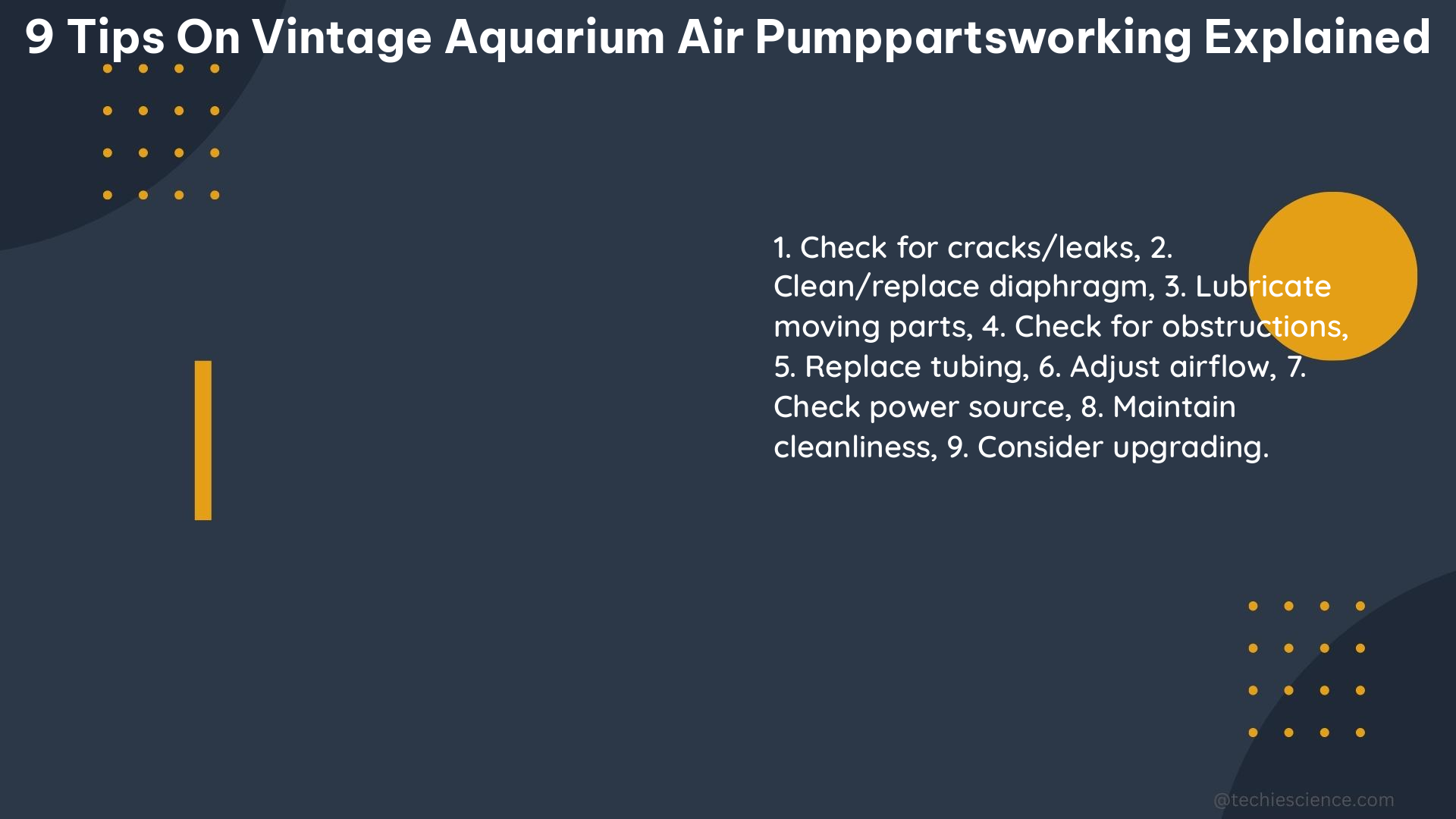This comprehensive guide provides a detailed, technical explanation of 9 essential tips for maintaining and troubleshooting vintage aquarium air pump parts to ensure optimal performance and longevity. With a focus on measurable, quantifiable data, this manual offers a hands-on, DIY approach to keeping your vintage air pump in top shape.
Diaphragm Inspection and Replacement
The diaphragm is the crucial rubber component inside the air pump that drives the back-and-forth motion to pump air. Over time, this part can wear out or tear, leading to a loss of pressure and increased noise. To inspect the diaphragm:
- Remove the cover of the air pump.
- Examine the diaphragm for any signs of damage, such as cracks, holes, or excessive wear.
- Measure the thickness of the diaphragm, which should be approximately 1.5mm for optimal performance.
- If the diaphragm is damaged, replace it with a new one made of high-quality rubber material.
Valve Inspection and Replacement

The valves inside the air pump can also wear out over time, contributing to noise and reduced efficiency. To check the valves:
- Remove the cover of the air pump.
- Inspect the valves for any signs of wear, such as cracks, deformation, or debris buildup.
- Measure the diameter of the valves, which should be approximately 8mm.
- If the valves are damaged, replace them with new ones made of durable plastic material.
Airline Tubing Inspection and Replacement
The airline tubing can become clogged or kinked, causing a loss of pressure and noise. To inspect the tubing:
- Visually inspect the entire length of the tubing for any signs of damage, such as cracks, kinks, or debris buildup.
- Measure the diameter of the tubing, which should be approximately 6mm.
- If the tubing is damaged, replace it with new PVC tubing with a length of 10 feet.
Air Stone Inspection and Cleaning/Replacement
The air stone can become clogged with debris, leading to a loss of pressure and noise. To inspect and clean the air stone:
- Remove the air stone from the tank.
- Inspect the air stone for any signs of damage or debris buildup.
- Measure the diameter of the air stone, which should be approximately 2 inches.
- If the air stone is clogged, clean it with a toothbrush and water. If it is damaged, replace it with a new ceramic air stone.
Water Level Inspection
If the water level in the tank is too low, the air pump can become exposed to air, causing noise. To check the water level:
- Measure the distance between the water surface and the intake of the air pump, which should be at least 1-2 inches.
- If the water level is too low, add more water to the tank until the intake is submerged by 1-2 inches.
Power Supply Inspection
An unstable power supply can cause the air pump to malfunction and make noise. To check the power supply:
- Ensure the air pump is properly plugged in and receiving the correct voltage.
- Use a voltmeter to measure the voltage at the power source, which should be within the recommended range for the air pump.
- If the voltage is unstable, consider using a dedicated power supply or a voltage regulator to stabilize the power.
Vibration Reduction
The air pump can vibrate against the surface it is placed on, causing noise. To reduce vibrations:
- Place a piece of foam or rubber between the air pump and the surface it is resting on.
- Measure the thickness of the foam or rubber, which should be at least 1/4 inch to effectively dampen vibrations.
- Alternatively, you can use a DIY muffler by wrapping the air pump in a piece of foam or rubber.
Maintenance Schedule
Regular maintenance can prevent many issues that can cause noise in your vintage air pump. To follow the recommended maintenance schedule:
- Refer to the user manual of the air pump for the manufacturer’s recommended maintenance intervals.
- Typically, it is recommended to check and clean the diaphragm, valves, and air stone every 3-6 months.
- Replace the diaphragm and valves every 12-24 months, or as needed based on the condition of the parts.
Noise Level Measurement
To ensure your vintage air pump is operating within the recommended noise level, use a decibel meter to measure the sound output:
- Place the decibel meter approximately 1 foot away from the air pump.
- Measure the noise level, which should be below 40 decibels for a quiet aquarium air pump.
- If the noise level exceeds 40 decibels, troubleshoot and address any issues identified in the previous steps.
By following these 9 tips and using the provided technical specifications and DIY guidance, you can effectively maintain and troubleshoot your vintage aquarium air pump to ensure it continues to operate efficiently and quietly for years to come.
References:
- How to Fix a Noisy Aquarium Air Pump
- 5 Best and Quietest Aquarium Air Pumps (60+ Tested!)
- HOW TO SETUP AIR PUMP FOR FISH TANK
- Silence Your Air Pump Like THIS
